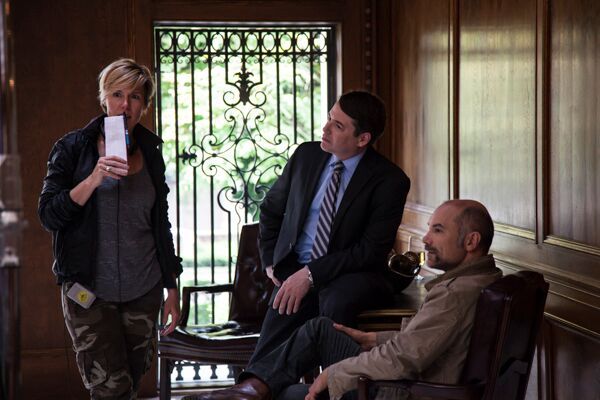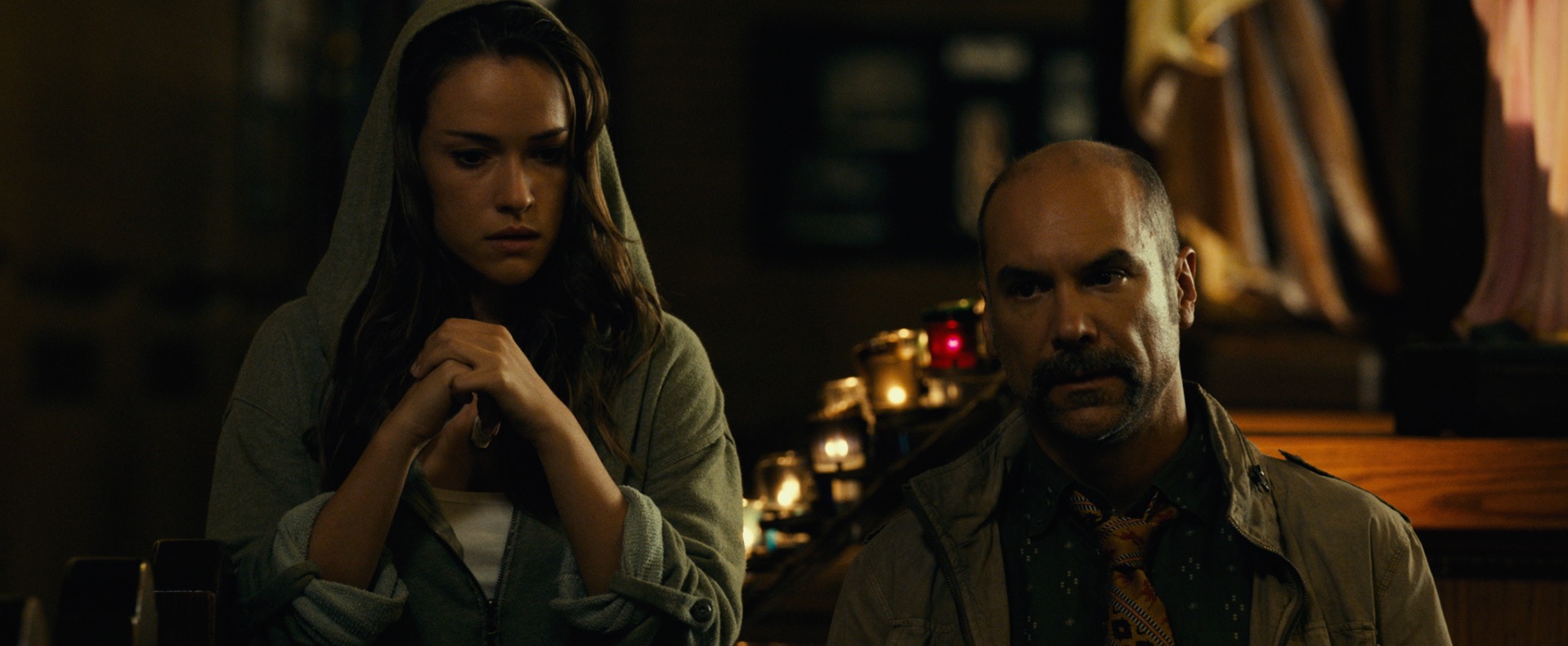This guest post written by Jenna Ricker appears as part of our theme week on Women Directors.
“Man is defined as a human being and a woman as a female — whenever she behaves as a human being she is said to imitate the male.” – Simone de Beauvoir
There I was, waiting to be introduced at my first film festival for my first feature film. My stomach was all butterflies. Not sweet lilting flappers, but juiced up buggers pinging around at breakneck speed, swirling with worry about whether the audience would like my movie, or walk out, or worse… what if someone had smuggled in a tomato?
As I stood there trying to play it cool, the festival programmer began talking about my film — a coming of age drama about a young boy who, while searching for his absentee mother, re-connects with his older half-brother— in a way I hadn’t anticipated. While I know he meant to be flattering, I was struck by how many times I heard a variation of this phrase: How did she write and direct this masculine story so well as a woman?
The butterflies, struck dumb by confusion, stopped swirling. I didn’t know I’d written a masculine story. I’d heard of chick-flicks, which I imagined to be movies that chickens watched in the comfort of their coops, but was ‘masculine’ a legit genre? I rattled the usual suspects off in my head — comedy, drama, thriller, horror, masculine, feminine — hold up, what?
Cut to a few years later. I’ve got the same butterflies as I wait to be introduced at a different festival for the premiere of my second feature film — this one a noir-inspired mystery about a conspiracy to control a revolutionary design by inventor, Nikola Tesla. The festival programmer passionately described the film, talked beautifully about our wonderful cast and then with a nod in my direction said — When you meet this director you won’t believe she made such a dark, masculine film. My butterflies gave me a swift kick in the gut.
Here’s the thing — all of the festival programmers who described my films as ‘masculine’ genuinely liked and celebrated my work. They were wonderfully gracious, and no doubt intended to be complimentary, and I’m eternally grateful that they saw something they appreciated and wanted to include in their festivals. But, it got me to thinking.
What makes a story masculine or feminine?
I did some research, reading articles and excerpts that addressed gender identity, feminist literature, sexuality, but I came up short on finding research on assigning gender to stories. What I did discover is that over 80 languages have nouns, verbs and adjectives that are deemed masculine or feminine. Are you suddenly having flashbacks to freshman year Spanish?
In our current political climate it might be easy to forget that words have meanings, however, in these languages gender is inextricably tied to the cultural interpretation. As Mark Twain noted in A Tramp Abroad, “In German, a young lady has no sex, while a turnip has… A tree is male, its buds are female, its leaves are neuter; horses are sexless, dogs are male, cats are female… tomcats included.” While English doesn’t officially have ‘gender-words’, it does have gender-connotations. Take pronouns, for example. I say doctor, you say? He. I say nurse, you say? She. (If you didn’t, congratulations, you’re one in a million.) Language is powerful, like stories, and it would appear our socialization subconsciously compels us to assign gender to both. What’s that about?
There are ‘female-driven’ stories, like Silkwood, and there are ‘male-driven’ stories, like Tootsie; stories driven by the main characters’ gender AND their storyline, which is distinct from ascribing a gender to a story. What the festival programmers didn’t realize, because it’s something that runs deep inside us all, was that their need to label the story by gender was tied wholly to the fact that a woman had directed it. Do you think anyone said to Sydney Pollack, “How did you direct such a feminine film?” when The Way We Were hit theaters. Was James L. Brooks inundated with questions like, “How did you understand such feminine characters?” when he helmed Terms of Endearment? Yeah, I doubt it, too.
But, when was the last time ANYONE sat down to write a story, or direct a project and asked themselves — Is this story masculine or feminine? Exactly none, I suspect. Why is every-day filmmaking ‘for the boys’ cast through an entirely different lens when it comes to the women? Kathryn Bigelow’s Hurt Locker was powerfully executed, and I guarantee the phrase, “Can you believe a woman directed it?” was used by many while exiting the theaters. But did those same folks walk out of The Hours wondering how Stephen Daldry managed to pull it off? Storytellers tell stories, audiences engage, the formula is quite simple. But, it only works one way — male filmmakers are able to make any film they want without biased-loaded gender questions, whereas women filmmakers always face more scrutiny and criticism.
A couple of yeas ago I was on a ‘Women in the Director’s Chair’ panel with these inspiring women filmmakers and we were discussing this need to place gender on story solely when the storyteller was female. Debra Granik (Winter’s Bone, Stray Dog) shared that it had been suggested to her that maybe the way to combat this was to use a male nom-de-plume, or try submitting a script with just one’s initials to see if that changed the reaction or greased the wheels. But, as we all surmised, then what? You’re sitting across from a producer who thought you were a man, and now you’re having an awkward ‘gotcha moment’? And, besides, who wants to pretend to be someone else when it’s already hard enough being yourself in this industry.
This is not just a nuisance but a symptom of a much larger problem: Women writers and directors are already hindered by gender labels miles from the finish line. Other marginalized writers and directors are impeded as much, if not more, when it comes to storytelling. As difficult as it is for all women filmmakers, it’s even more difficult for women of color, LBTQ women and women with disabilities. And, while making a movie is incredibly hard for anybody — it takes ridiculous amounts of stamina and unwavering focus, no matter your gender — when a woman wants to tell a story, her obstacle course is often fraught with more walls to scale, barbed-wire to beat, and fire pits to leap over.
And one of the biggest obstacles, in my opinion, is this need to label a woman’s storytelling as either masculine or feminine. This is yet another Catch-22 for a woman director. You want to tell a story about a World War II battlefield? The gatekeepers will decide that’s probably better told by a man. You want to tell a story about a World War II nursing station? Okay, but the gatekeepers will tell you that no one is going to watch it because it’s about women. This denotes that the first story is masculine and the second feminine, regardless of the actual subject matter. And so it goes…
Ironically, what is more likely to happen is a male director being celebrated for telling female-driven fare. You know, those big ‘chick flicks’ of the that last few years — Bridesmaids, Sisters, Trainwreck, Crazy, Stupid, Love, and the coming Ghostbusters reboot — all directed by men. This means three things, as far as I can guess: 1.That women in leading roles means chicken-coop watching is going to be huge, 2. These films made heaps of money at the box-office, but there is no trickle-up-effect from female-driven stories to female-helmed stories, and 3. If you’re subscribing to this notion that stories are either female or male, then why aren’t women directing these films? I’m not subscribing to this notion, nor taking the Paul Feig’s or Judd Apatow’s to task. I love that they’re casting women in numbers, and clearly making movies that excite them, and further, I don’t blame them for the asinine term ‘chick-flick’ either, but if I ever meet the coiner of that phrase in a dark alley…
Look, this is not ground-breaking territory I’m covering, just another voice in the chorus of frustration at our industries’ blatant gender parities. So what do we do about it? Well, if it were that simple we would’ve leveled the playing field and gotten on with storytelling already. But, getting on with storytelling is helping. As Melissa Silverstein wrote in an IndieWire article “Embracing the Female Gaze“:
“There are women all across this industry taking hammers each and every day to bang away at the glass ceiling that creates this deep inequality in storytelling. Women are picking up hammers by making their own films in any way they can by creating and participating in female film groups and helping each other, as well as using social media to spread the word about the desire for change.”
To push the needle, women have to keep finding a way outside the system to make movies that challenge the status quo. Hiring women in key roles on crews changes the landscape of a production, and starts to chip away at the ‘boys club’ until a woman’s credits start to pile up next to her male counterparts and the excuse of ‘no experience’ becomes a non-starter. More media outlets that create more opportunities for work to be seen is another potential game changer. What other ways can we start to erode at the gender story trap? I’d love to hear your thoughts.
Jenna Ricker is a writer/director based in New York City. She received the Mira Nair Award for Rising Female Filmmaker for her first film, Ben’s Plan. Her second feature film The American Side premieres in theaters April 22nd.
First image photo credit: Frank Barrera; second image photo credit: Ginny Stewart.

